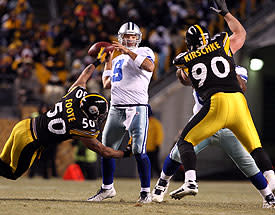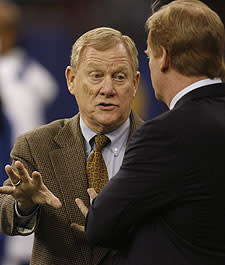QB development a concern of longer season
DANA POINT, Calif. – As the NFL continues to build momentum toward an expanded regular season and a decrease in the number of preseason affairs, there's a daunting question for coaches, players and fans to consider: How do you develop and evaluate quarterbacks?
With commissioner Roger Goodell making it clear this week during the owners meetings that the league will eventually expand to a 17- or 18-game regular season, plenty of questions have been raised about the impact a reduced preseason will have on players, particularly signal callers. And while instant solutions have been provided – from more practice time to expanded training camps – losing those plays under the lights of even preseason action could create problems.

The Cowboys were able to assess Romo, center, during preseason action.
(Matthew Emmons/US Presswire)
There is also the injury factor. Indianapolis Colts president Bill Polian, who has data from when the NFL increased from 14 to 16 games in 1978, said there was an increase in the number of players who missed four games or more.
For example, would the Green Bay Packers been able to properly develop and evaluate quarterback Aaron Rodgers if he operated with fewer preseason games as they made the transition from Brett Favre? Would the Dallas Cowboys been able to get former undrafted free agent Tony Romo up to speed? And how would the Cleveland Browns make the most educated decision possible about whom is better between Derek Anderson and Brady Quinn?
"Obviously, we're going to have to come up with answers to these problems," Polian said. "If this is what the owners want and what the players agree to, we don't have a choice but to adapt and we will. But there are all sorts of issues that go with doing this."
In other words, increasing the schedule to help offset the growing costs of running an NFL team may seem like a simple solution. For people such as Polian who have to manage rosters and deal with injuries to keep a team competitive, it's hardly a panacea. It's really like a bad migraine.
"There are two models for this: the Canadian [Football] League and the [long defunct] USFL," said Polian, who worked in each league during the 1980s. "In both those leagues, you were looking at an 18-and-2 format."
By that, Polian is referring to having 18 regular-season games and only two preseason games. Currently, the NFL has a 16-and-4 format and would keep any season to a combination of 20 games.
"In order for us to go to a 17- or 18-game schedule a number of factors will have to be considered," Tennessee Titans center and NFLPA president Kevin Mawae said. "Player safety and welfare and compensation are the first things that come to mind. This idea is not as simple as just paying players for two more games."
And dealing with the logistics of whatever the owners and players eventually agree to becomes a challenge for the likes of Polian to conquer.
"Two things happened there that were interesting [in the USFL]. First, your team was in flux until Week 6 because you didn't have enough looks to figure out who was really good and who really wasn't," Polian said. "Now that was in large part a start-up situation, so some of that will be scaled back and it's really probably going to be Week 2 or 3 of the season when you really have a handle of you team.
"Really, it's the whole team. Obviously, there are some core people who you know will be good. But a significant portion of your team was in flux when we did that. Second, the development of players and who really gets developed is at issue in the preseason. Nothing can replace those preseason looks that players get."
That's particularly true for quarterbacks. With the NFL already losing the NFL Europe developmental league (though there's talk of another such league being created) and dealing with the suspension of the Arena League this season, finding places for quarterbacks to play is getting harder.
"You see players during training camp who show you one thing and then that [preseason] game goes on and it's something else, either positively or negatively, where you say, 'Who is that guy?' " New Orleans Saints coach and offensive guru Sean Payton said.
Payton and New York Giants coach Tom Coughlin talked about the other issues, such as how much practice time a team might need to get ready for the season.
"The thing you're always concerned about is do you have enough time to get your young people evaluated and can you condition and prepare your team for the long regular season," Coughlin said.
"It really comes down to, how long does it take to get your team read to play a regular-season game?" Payton said. "Is it four weeks? Is it five weeks? Six?"
Yet, while so much attention has been placed on preseason and preparation, an extended campaign would impact the whole NFL calendar.
"What happens to the Senior Bowl, the [scouting] combine, the Pro Bowl, the start of free agency, all of those things?" Payton asked. "There's the start of the offseason program. It's any number of things that would have to be adjusted."
Coughlin said that the injured reserve rule might also have to be changed, where players might be allowed to return later in the season. An example of that would be Giants defensive end Osi Umenyiora, who was lost in training camp with a torn anterior cruciate ligament in his right knee. Coughlin said that team doctors advised that Umenyiora wouldn't make it back for the 2008, but recovery time for any injury isn't easy to project.
"Let's just say, particularly in this day and age and the quality level of our players, it would mean so much more if you could bring a guy back … I don't think there's anyone who doesn't feel that if you could do this, it would really help our game," Coughlin said. "If you had the ability to bring a guy like that back, the fans would be excited, too."

Polian, left, talks to Goodell prior to a postseason game in 2008.
(Brian Spurlock/US Presswire)
Polian acknowledged that even if the preseason is reduced to two games, coaches will likely add intrasquad scrimmages or scrimmages against other teams to replace the preseason games.
"Yes, absolutely. I still think you will gravitate toward four contests of some kind [before the season starts] to measure the quality of your young people, so I do think that's something that will take place," Polian said.
In addition, executives could push for increased rosters or increased practice squads. While that seems easy enough, fitting in an extra scrimmage could require an earlier start to training camp. Furthermore, coaches will likely want to have more access to players for offseason classroom work, a likely point of contention for players.
"I don't think you can come up with a total number of injuries right now, but you obviously expect there to be more potential for injuries," Baltimore Ravens general manager Ozzie Newsome said.
Numerous players, such as Mawae, have expressed concern about the increased injury risk. Polian took it a step further.
"The unknown is how injuries will effect the postseason," Polian said. "As you come toward the end of the season, will injury rates rise as the playoffs near …?"
